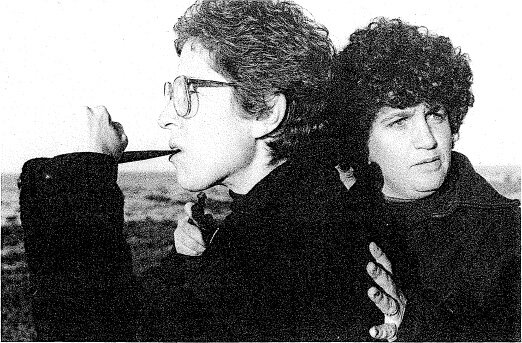BUTCH-FEM RELATIONSHIPS : Sexual Courage from the 1950s
Posted by: Kevin Coyle
The following is an excerpt from Joan Nestle’s article that appeared in “HERESIES: A Feminist Publication on Art and Politics,” Volume 5, No. 4, Issue 12, 1981 – “The Sex Issue.” It is featured here courtesy of Joan Braderman, a founding member of HERESIES.
For many years now I have been trying to figure out how to explain the special nature of butch-fem relationships to lesbian-feminists who consider butch-fem a reproduction of heterosexual models. My own roots lie deep in the earth of this lesbian custom, and what follows is one lesbian’s understanding of her own experience.
In the late 1950s I walked the streets looking so butch that straight teenagers called me a bull-dyke; however, when I went to the Sea Colony (a working-class Lesbian bar in Greenwich Village, New York) looking for my friends and sometimes for a lover, I was a fem, a woman who loved and wanted to nurture the butch strength in other women. I am now 40 years old; although I have been a lesbian for over 20 years and I embrace feminism as a world view, I can spot a butch 50 feet away and still feel the thrill of her power. Contrary to belief, this power is not bought at the expense of the fem’s identity. Butch-fern relationships, as I experienced them, were complex erotic statements, not phony heterosexual replicas. They were filled with a deeply lesbian language of stance, dress, gesture, loving, courage, and autonomy. None of the butch women I was with, and this included a passing woman, one ever presented themselves to me as men; they did announce themselves as tabooed women who were willing to identify their passion for other women by wearing clothes that symbolized the taking of responsibility. Part of this responsibility was sexual expertise. In the 1950s this courage to feel comfortable with arousing another woman became a political act.
Butch-fem was an erotic partnership, serving both as a conspicuous flag of rebellion and as an intimate exploration of women’s sexuality. It was not an accident that butch-fem couples suffered the most street abuse and provoked more assimilated or closeted lesbians to plead with them not to be so obvious. An excerpt from a letter by Lorraine Hansberry, published in The Ladder in 1957, shows the political implications of the butch-fem statement; it is a plea for discretion because, I think, of the erotic clarity of the butch-fem visual image.
Someday I expect the “discreet” lesbian will not turn her head on the streets at the sight of the “butch” strolling hand in hand with her friend in their trousers and definitive haircuts. But for the moment it still disturbs. It creates an impossible area for discussion with one’s most enlightened (to use a hopeful term) heterosexual friends.
A critic of this essay has suggested that what was really the problem here was that “many other lesbians at that time felt that the adoption of culturally defined roles by the butch-fem was not a true picture of the majority of lesbians; they found these socialized roles a limiting reality and therefore did not wish to have the butch-fem viewpoint applied or expressed as their own.” My sense of the time says this was not the reason. The butch-fem couple embarrassed other lesbians (and still does) because they made lesbians culturally visible – a terrifying act for the 1950s. Hansberry’s language – the words “discreet” and “definitive” – is the key, for it speaks of what some wanted to keep hidden: that is, the clearly sexual implications of the two women together.

